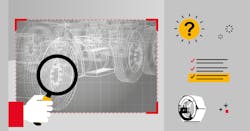Tech Tip: Fact or fiction? The more one tightens, the better.
Supervisors and maintenance managers need to ensure that the heavy vehicles or machinery that go through the shop are appropriately maintained following manufacturers' specifications, especially when it comes to tightening applications. One specific area that needs attention is tire changing.
Questions shops should ask technicians to ensure right amount of torque is applied include:
- Are ‘blue books’ available?
- How often are internal tightening processes reviewed?
- Is surface preparation carried out as standard during processes?
- Are the tools used ensured to reach the right torque?
Tire changing on any type of vehicle is a regular job for techniciansand it can seem quite straight forward. As such, operators can tend to overlook the tightening specifications recommended by the vehicle manufacturers. This practice should be avoided, however, as it can lead to downtime and serious safety consequences.
Common misconceptions “heard in the field” when tightening
- The more one tightens, the better. False. In most cases, more torque means more tension applied to a bolt, resulting in overtightening which increases the risk of stud break.
- The more a truck is carrying, the more one needs to tighten. This is a myth; manufacturers’ recommended torque specifications should be followed at all times. Believing this myth can lead to overtightening and its disastrous consequences.
- To get the right torque applied, one just needs to count 1, 2, 3 while tightening. Well …, that’s false. Proper torque requires using the correct tools, procedures, and patterns.
Recommendations to share with technicians to get the right tightening:
Be aware of the manufacturers’ specifications and refer to them.
Manufacturers always provide recommendations for each tightening job, and these can be found in the specifications book or maintenance manual, which is more commonly called a ‘blue book’. Before one starts tightening they should double-check the book to ensure the job is performed to the best standard.
With new innovations in materials and tools, it’s important to keep knowledge current and follow the latest specifications. For example, nowadays most wheel rims are made from aluminum instead of steel but this does not mean that aluminum rims are harder and more torque is needed. The rim material affects the torque that should be applied. Continuous training is highly recommended and this can be offered by different providers.
Surface preparation is key
A substantial amount of torque is “lost” or wasted by friction during tightening. Therefore, we advise preparing the surface properly by cleaning all the elements to eliminate any rust, dust, and dirt. Once cleaning is finished and before tightening inspect all components: wheel, studs, and long nuts.
Information provided by Chicago Pneumatic
